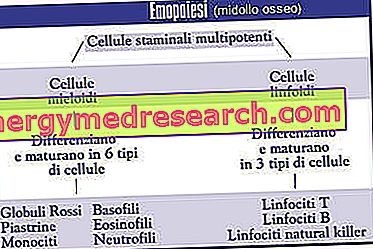Generality
Premise
Blood cells originate in the bone marrow, a liquid tissue that is present throughout the skeleton at birth, while in the adult it is mainly located inside flat bones, such as the sternum, the pelvis, the skull and the ribs.
The process of formation and maturation of blood cells is called hematopoiesis .
Hematopoiesis occurs thanks to the ability of the bone marrow to produce immature hematopoietic cells, called multipotent or totipotent blood stem cells. These cells have the potential to differentiate into all the cell lines that make up blood (red blood cells or red cubes, white blood cells and platelets).

All blood cell types therefore derive from a single hematopoietic stem cell, which - depending on the stimulus or mediator that conditions cell differentiation - can follow different "differentiation" lines, up to morphologically and functionally characterize the different precursors (of white blood cells, red globules and platelets). Subsequently these fully functioning blood cells are developed from these precursors through a "maturation" process.
The "differentiation" and "maturation" lines can proceed in two main directions (figure):
- the lymphoid line from which the lymphopoiesis that gives rise to the lymphocytes (a type of white blood cell, specifically (B, T and NK lymphocytes or "NATURAL KILLER") starts
- the myeloid line from which myelopoiesis develops, a process that leads to the production of other white blood cells - which are monocytes and granulocytes (neutrophils, basophils, eosinophils) - but also of megakaryocytes (platelets) and mature red blood cells.
In the presence of leukemia the process described above does not work properly: a "crazy" bone marrow proliferates in an unlimited and autonomous way in a single direction, on the basis of which it will be referred to as lymphoid or myeloid leukemia. In both cases, this neoplastic proliferation (leukemias are "blood" tumors) subverts - in an acute and sudden way (acute leukemias) or slow and gradual (chronic leukemias) - the normal balance and functionality of blood cells, with consequences often dramatic for patient health.
Chronic myeloid leukemia (CML) is a myeloproliferative syndrome characterized by the proliferation and progressive accumulation of granulocyte cells at the medullary level.
The disease derives from the abnormal transformation of multipotent hematopoietic stem cells, which maintain the initial capacity to proliferate and differentiate but only towards the leukocyte line. A clonal population of immature granulocytes therefore accumulates in bone marrow and blood as a consequence of excessive clonal expansion, which may also affect other cellular series, such as those intended for the production of megakaryocytes (platelets), monocytes and sometimes even lymphocytes. Initially, the leukemic cells retain part of the ability to mature and produce "normal" blood cells, which partly explains the less aggressive course of CML compared to acute leukemias. Furthermore, in chronic myeloid leukemia, normal stem cells do not disappear completely and may reappear after the suppression, by pharmacological therapy, of the leukemic clone.
In short. Myeloproliferative syndromes.
Myeloproliferative syndromes are neoplastic diseases of the hematopoietic system characterized by the altered production of mature or immature cells of the myeloid lines (granulo-monocytic, platelet, erythrocytic). These neoplasms can be divided into acute, subacute and chronic : this distinction refers to the course and duration of the disease.
In particular, all chronic myeloproliferative syndromes are associated with bone marrow alterations and tend to develop, in advanced stages, into acute ones (for example, chronic myeloid leukemia, if left untreated, is destined to evolve on average in 5 years in acute leukemia ).
Causes
The cause of the pathology lies in a clonal anomaly of the myeloid stem cell. Chronic myeloid leukemia is one of the first diseases in which it was possible to identify a specific chromosomal alteration as a triggering factor: the Philadelphia chromosome, from the name of the city in which it was discovered and described in 1960. This alteration is not hereditary, so it is not present from birth and is acquired throughout life.
The first episode that helps to determine the beginning of the neoplastic evolution is not clear, but the events that promote the progression of the disease have been discovered and defined:
- An abnormal chromosome develops: the Philadelphia chromosome.
Human cells normally contain 23 pairs of chromosomes, the structural units in which DNA is organized, which contains the instructions (genes) that control the cells in our body.
In patients with chronic myeloid leukemia, the chromosomes of blood cells exchange genome segments reciprocally through a process called translocation; in particular, a fragment that detaches from chromosome 9 attaches itself to the broken portion of chromosome 22, while the fragment that detaches from chromosome 22 is positioned on the broken portion of chromosome 9. Thus a balanced translocation occurs involving the ends of the long arms of chromosomes 9 and 22, with formation of:
- a smaller chromosome 22 than those present in healthy subjects (called Philadelphia chromosome )
- a chromosome 9 which is elongated.

- The abnormal chromosome creates a new gene.
Key concepts: rupture on chromosome 9 occurs at the level of the gene called "ABL" (Abelson). Rupture on chromosome 22 instead involves the "BCR" gene ("breakpoint cluster region").
ABL, which undergoes a mutation due to rupture, binds to the remaining portion of the BCR gene on chromosome 22; from this fusion originates an anomalous gene called "BCR / ABL".
Deepening: the reciprocal translocation that creates the Philadelphia chromosome involves the proto-oncogene c-ABL (Abelson, a gene able to become an oncogene after having undergone an alteration), which is removed from chromosome 9 and inserted on chromosome 22, in correspondence of the BCR gene (Breakpoint Cluster Region): this event corresponds to the creation of the anomalous fusion gene BCR / ABL (in its new ABL site is fused with the BCR gene), which is transcribed producing a tyrosine kinase protein, capable of powerfully stimulate cell proliferation and reduce apoptosis.
- The new gene promotes the clonal proliferation of neoplastic cells.
Key concepts: The BCR-ABL fusion gene induces the production of an abnormal protein, which intervenes in the transformation of the stem cell from normal to leukemic.
Deepening: the problem is that the product of the translocation forms the BCR-ABL gene, which acts as an oncogene, therefore it is able to determine the dominant modality of the tumor transformation, encoding for a protein (p210) with strong tyrosine-kinase activity, which makes blasts (undifferentiated cells, which mostly contain the anomalous Philadelphia chromosome) "immortal".
The kinase activity provokes a proliferative advantage, which corresponds to a clonal disorder: the main result is a hyperplasia of the myeloid precursors in the bone marrow, while we witness the exaltation in the peripheral blood of mature elements of the neutrophil granulocyte series and their precursors, an increase in the number of eosinophils, monocytes and basophils.
Epidemiology
Chronic myeloid leukemia is the most frequent of myeloproliferative syndromes: it constitutes about 15-20% of all adult leukemias, with an incidence of 1-2 cases per 100, 000 individuals each year.
The disease can occur at any age, but it is rare in people under the age of 10 and only 10% of cases involve subjects between the ages of 5 and 20. The average age at diagnosis is 45-55 years. Chronic myeloid leukemia can occur in both sexes, although it is slightly more frequent in men than in women.
Symptoms
At the onset, chronic myeloid leukemia can be totally asymptomatic. Most patients experience a gradual decline in general conditions.
The symptoms, when present, are generic and of modest entity and may depend on the expansion of granulocytes and platelets - almost exclusively related to the increase in volume in the spleen (note that all chronic myeloproliferative diseases are characterized by splenomegaly) - or be caused by anemization. In most cases the diagnosis is random: in front of a simple routine blood count that presents leukocytosis or abnormal values of hemoglobin or platelets, the presence of chronic myeloid leukemia can be suspected. In 85% of cases the disease is diagnosed in the chronic phase.
The clinical signs that can be found are:
- Presence of Philadelphia chromosome;
- Reduced leukocyte alkaline phosphatase;
- Weight loss;
- Temperature;
- Increased susceptibility to infections due to decreased leukocyte activity;
- Night sweats;
- Arthralgia (pain affecting a joint and the tissue surrounding it);
- Hyperuricemia (pathological accumulation of uric acid in the blood);
- Abdominal pain in the right hypochondrium for splenic infarcts;
- Bone pains, if there is an intense medullary proliferation (especially in the late phases of the pathology).
Negative prognostic criteria
- Old age;
- Elevated leukocytosis, as it indicates a large tumor mass;
- splenomegaly;
- Blocking symptoms of bone marrow cell maturation and increased proliferation (accelerated phase);
- Increased peripheral blasts, increased anemization, thrombocytopenia, fever, bone pain, increased basophils and eosinophils.
Main clinical features of the CHRONIC MYELOID LEUKEMIA | ||
Hemorrhage | + + | PROGNOSTIC FACTORS |
Thrombosis | - |
|
Temperature | + | |
Bone pains | + | |
Hypertension | - | |
splenomegaly | 95% | |
Stages of the disease
The time between the biological onset of the disease and its clinical manifestation may vary from months to a few years. In fact, it is possible to distinguish in the natural clinical course of chronic myeloid leukemia four phases, which refer to the aggressiveness of the disease: initial phase, chronic phase, accelerated phase and blast crisis. The doctor determines the stage by measuring the percentage of diseased cells on healthy ones, in the blood or in the bone marrow. A higher percentage of pathological cells characterizes the most advanced stages of the neoplasm.
The stages of chronic myeloid leukemia are:
- Initial phase: asymptomatic. Leukocytosis is modest and the presence of the Philadelphia chromosome does not exceed 20%.
- Chronic phase (takes about 3-5 years): generally, it is the phase that presents the best response to treatment. The quality of life is generally good and we are witnessing the clonal expansion of the leukemic population, still able to differentiate normally.
- Accelerated phase : it represents an intermediate stage, where we see the progression of the disease: the leukemic cell loses the ability to mature and there is a reduction, until the disappearance, of normal stem cells, as well as assisting in the diffusion of specific chromosomal and molecular anomalies additional.
- Crisis blast . The disease evolves clearly in acute myeloproliferative syndrome, with accumulation of transformed blasts, blocked at an early stage of differentiation and by further chromosomal alterations such as a second Philadelphia chromosome, the trisomy of chromosome 8, isochromosome 17 and other changes to load of chromosomes 1, 3, 19, 20 and 21.



